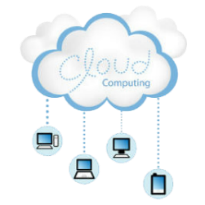
Free yourself from traditional IT with Cloud Services
Cloud computing is a blanket term for managed, shared applications, development platforms, or computing infrastructure accessible via the Internet. It provides options such as bandwidth and on-demand computing power with flexible capabilities normally purchased as a metered service.
The National Institute of Standards and Technology (NIST) defines cloud computing as a "model for enabling ubiquitous, convenient, on-demand network access to a shared pool of configurable computing resources (e.g., networks, servers, storage, applications, and services) that can be rapidly provisioned and released with minimal management effort or service provider interaction." NIST lists five essential characteristics:
- On-Demand Self Service - A consumer can unilaterally provision computing capabilities, such as server time and network storage, as needed automatically without requiring human interaction with each service provider.
- Broad Network Access - Capabilities are available over the network and accessed through standard mechanisms that promote use by heterogeneous thin or thick client platforms (e.g., mobile phones, tablets, laptops, and workstations).
- Resource Pooling - The provider's computing resources are pooled to serve multiple consumers using a multi-tenant model, with different physical and virtual resources dynamically assigned and reassigned according to consumer demand. There is a sense of location independence in that the customer generally has no control or knowledge over the exact location of the provided resources but may be able to specify location at a higher level of abstraction (e.g., country, state, or datacentre). Examples of resources include storage, processing, memory, and network bandwidth.
- Measured Service - Cloud systems automatically control and optimise resource use by leveraging a metering capability at some level of abstraction appropriate to the type of service (e.g., storage, processing, bandwidth, and active user accounts). Resource usage can be monitored, controlled, and reported, providing transparency for both the provider and consumer of the utilized service.
- Rapid Elasticity - Capabilities can be elastically provisioned and released, in some cases automatically, to scale rapidly outward and inward commensurate with demand. To the consumer, the capabilities available for provisioning often appear to be unlimited and can be appropriated in any quantity at any time.
According to NIST, cloud computing is deployed four ways over three service models. The three service models are:
- Software as a Service (SaaS) -The capability provided to the consumer is to use the provider's applications running on a cloud infrastructure. The applications are accessible from various client devices through either a thin client interface, such as a web browser (e.g., web-based email), or a programme interface. The consumer does not manage or control the underlying cloud infrastructure including network, servers, operating systems, storage, or even individual application capabilities, with the possible exception of limited user-specific application configuration settings.
- Infrastructure as a Service (IaaS) -The capability provided to the consumer is to provision processing, storage, networks, and other fundamental computing resources where the consumer is able to deploy and run arbitrary software, which can include operating systems and applications. The consumer does not manage or control the underlying cloud infrastructure but has control over operating systems, storage, and deployed applications; and possibly limited control of select networking components (e.g., host firewalls).
- Platform as a Service (PaaS) - The capability provided to the consumer is to deploy onto the cloud infrastructure consumer-created or acquired applications created using programming languages, libraries, services, and tools supported by the provider. The consumer does not manage or control the underlying cloud infrastructure including network, servers, operating systems, or storage, but has control over the deployed applications and possibly configuration settings for the application-hosting environment.
The four deployment models are:
- Public Cloud - The cloud infrastructure is provisioned for open use by the general public. It may be owned, managed, and operated by a business, academic, or government organisation, or some combination of them. It exists on the premises of the cloud provider.
- Private Cloud - The cloud infrastructure is provisioned for exclusive use by a single organisation comprising multiple consumers (e.g., business units). It may be owned, managed, and operated by the organisation, a third party, or some combination of them, and it may exist on or off premises.
- Community Cloud - The cloud infrastructure is provisioned for exclusive use by a specific community of consumers from organisations that have shared concerns (e.g., mission, security requirements, policy, and compliance considerations). It may be owned, managed, and operated by one or more of the organisations in the community, a third party, or some combination of them, and it may exist on or off premises.
- Hybrid Cloud - The cloud infrastructure is provisioned for exclusive use by a single organisation comprising multiple consumers (e.g., business units). It may be owned, managed, and operated by the organisation, a third party, or some combination of them, and it may exist on or off premises.
